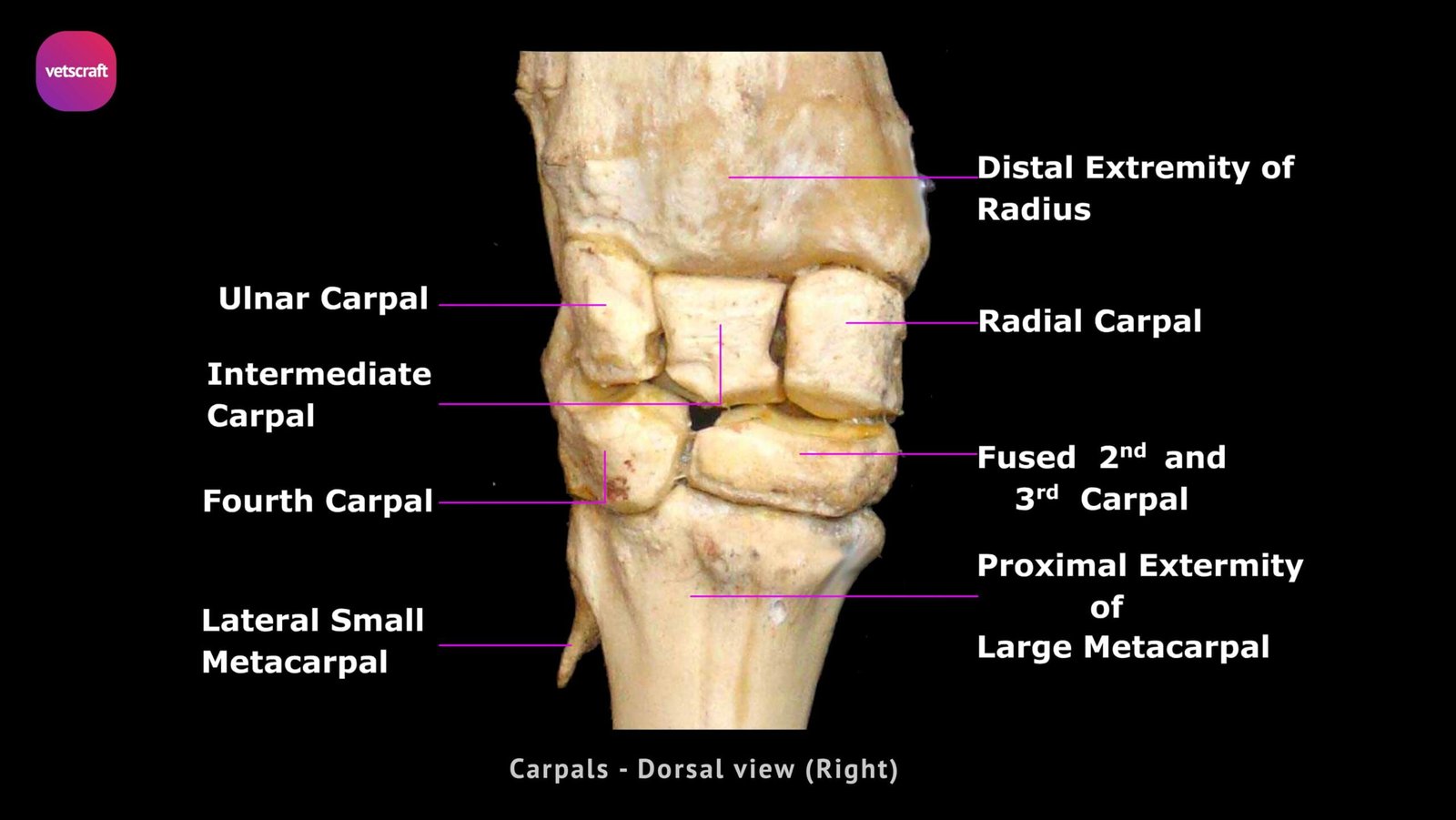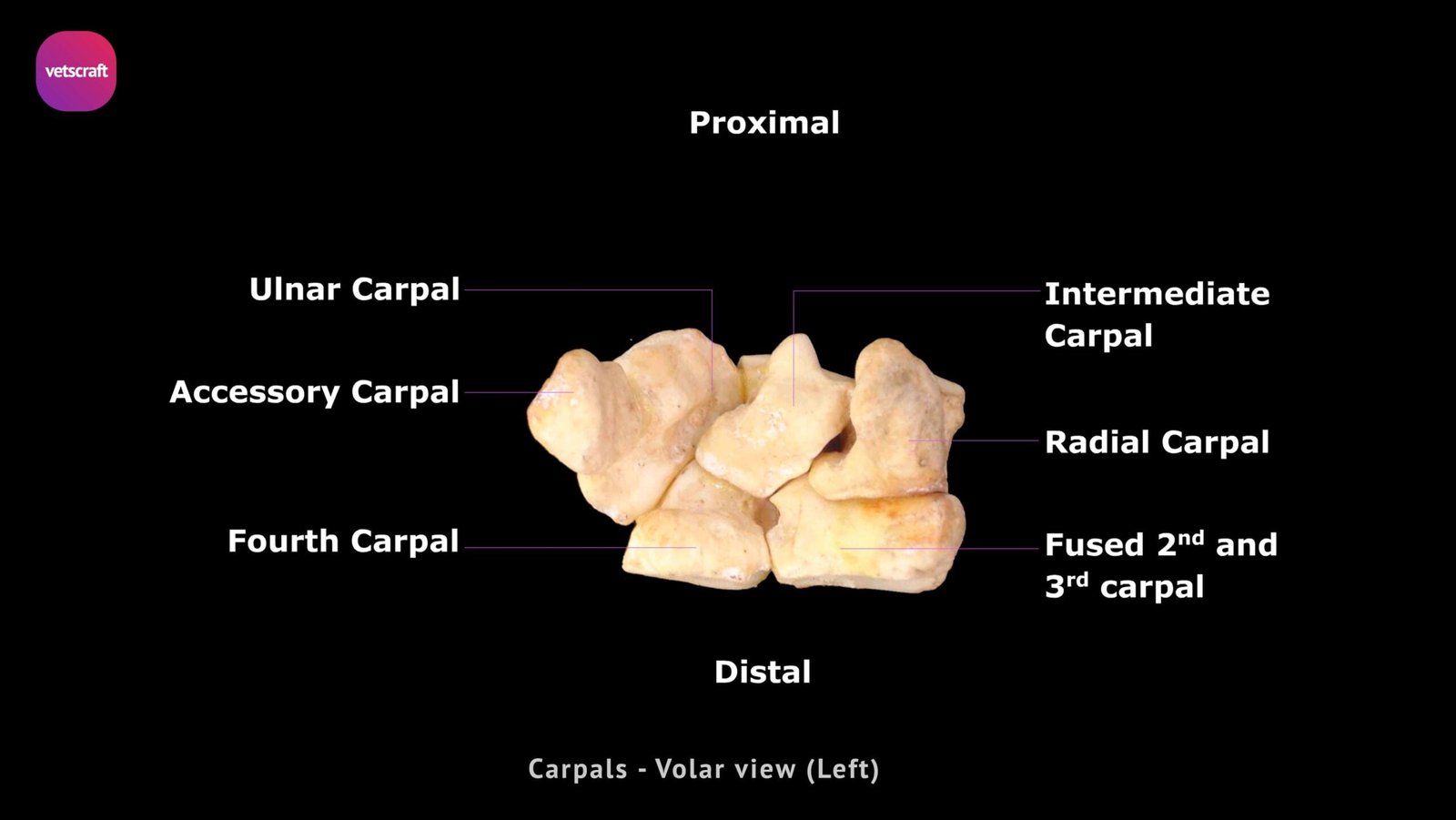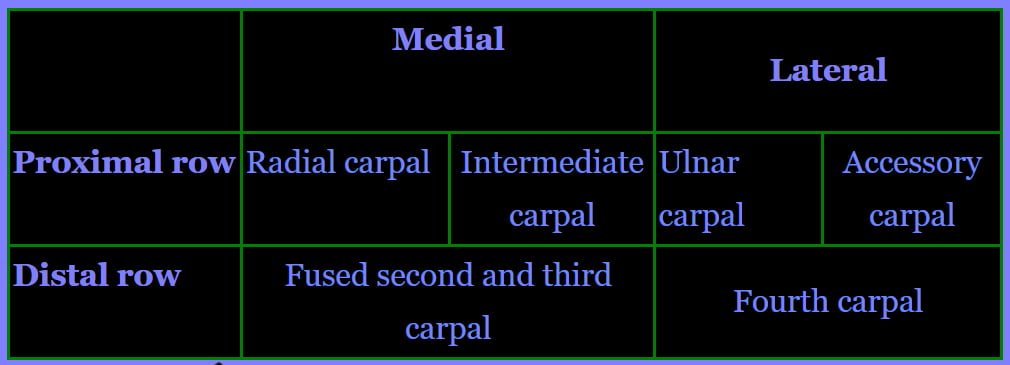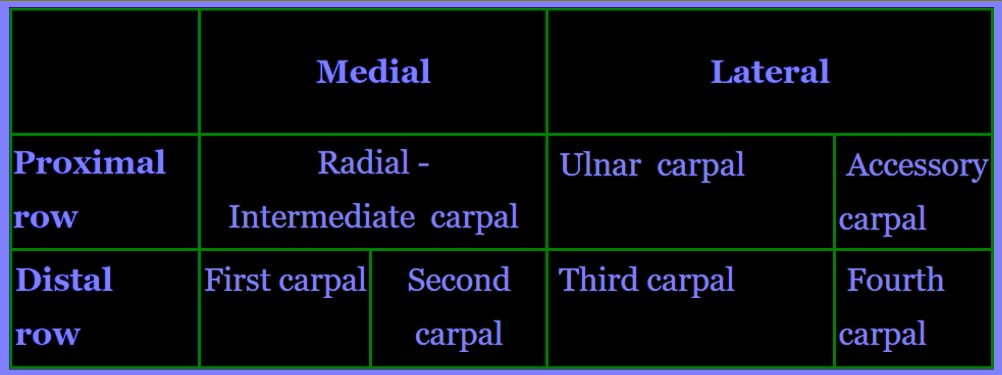TABLE OF CONTENTS
Carpal Bones of Animals: Comparative Anatomy in Domestic Species
The carpal bones form the knee joint (in quadrupeds) and connect the forearm (radius and ulna) to the metacarpus.
These bones are arranged in two rows: proximal and distal. The number, fusion, and shape of the carpal bones vary by species depending on limb use (e.g., weight-bearing vs. manipulative).

Carpals of Ox
The carpus consists of six bones arranged in two rows — four in the proximal row and two in the distal row. They are short bones.




Radial Carpal (Scaphoid)
The radial carpal (scaphoid) is the largest bone of the upper row.
- The proximal surface is convexo-concave from front to back and articulates with the radius.
- The distal surface articulates with the fused second and third carpals.
- The lateral face bears facets for the intermediate carpal.
- The dorsal, medial, and volar faces are continuous and rough.
Intermediate Carpal (Lunar)
The intermediate carpal (lunar) is wedge-shaped.
- The dorsal face is rough and forms the base.
- The apex is posterior and prolonged medially.
- The proximal face is convexo-concave from front to back and articulates with the radius.
- The distal face is divided by a sagittal ridge into two facets for the second, third, and fourth carpals.
- The medial face has facets for the radial carpal.
- The lateral face articulates with the ulnar carpal.
Ulnar Carpal (Cuneiform)
The ulnar carpal (cuneiform) is very irregular.
- The proximal face is obliquely directed backward and downward, encroaching on the distal face and articulating with the fourth carpal.
- The medial face has facets for the intermediate carpal.
- The dorsal face is rough and convex.
- The volar face has a facet for the accessory carpal.
Accessory Carpal (Pisiform)
The accessory carpal (pisiform) is short, thick, and rounded.
- It is a sesamoid bone situated behind the ulnar carpal.
- The proximal face is narrow and rough for the attachment of the flexor carpi ulnaris and ulnaris lateralis.
- The distal face is broad and rough.
- The dorsal face has a facet for the ulnar carpal.
Fused Second and Third Carpal (Os Magnum)
The fused second and third carpal (os magnum) is the largest of the carpals and the medial bone of the two in the distal row.
- The proximal face has two facets— the medial one is larger for the radial carpal, and the lateral one is smaller for the intermediate carpal.
- The distal face articulates with the large metacarpal.
- The lateral face has facets for the fourth carpal.
- The medial and dorsal faces are continuous, rough, and convex.
Fourth Carpal (Unciform)
- The proximal face has two facets for the intermediate and ulnar carpals.
- The distal face articulates with the large metacarpal.
- The medial face has facets for the fused second and third carpals.
- The dorsal and lateral faces are continuous and rough.
Carpals of Sheep and Goats
The carpals in sheep and goat resemble those of the ox. The accessory carpal is longer and less tuberous.
Carpals of Horse
The horse has seven or eight carpal bones.
- Radial Carpal: Resembles that of the ox.
- Intermediate Carpal: The lateral angle of its proximal face is more pointed.
- Ulnar Carpal: The smallest bone of the proximal row. The proximal face articulates only with the radius.
- Accessory Carpal: It is discoid. The medial face is concave and the lateral is convex and rough. A smooth groove for the long tendon of the ulnaris lateralis crosses its anterior part obliquely downward and slightly forward. The anterior border has two facets — the upper is concave for the radius, and the lower is convex for the ulnar carpal.
- First Carpal (Trapezium): It is inconstant; when present, it is situated behind the second.
- Second Carpal (Trapezoid): It is the smallest bone of the distal row. The proximal face has a convex facet for the radial carpal. The distal face is flat and articulates with the medial small and large metacarpals. The lateral face has two facets for the third carpal. The dorsal and medial faces are continuous and rough.
- Third Carpal (Os Magnum): It is the largest carpal. It is irregularly triangular, with the base anterior. The proximal face articulates with the radial and intermediate carpals, and the distal face with the large and medial small metacarpals. The medial border is more concave than the lateral.
- Fourth Carpal (Unciform): The proximal face is convex and articular, and it encroaches on the lateral face. The distal face articulates with the large and lateral small metacarpals. The medial face has two facets for the third carpal.
Carpals of Pig
The pig has eight carpal bones — four in each row.

The bones of the proximal row resemble those of an ox, except that the accessory carpal is similar to that of the horse but lacks a lateral groove. The first carpal is small, elongated anteroposteriorly, rounded, and articulates anteriorly with the second carpal.
Carpals of Dog
The dog has seven carpal bones — three in the proximal row and four in the distal row. The radial and intermediate carpals are fused.

Carpals of Rabbit
The rabbit has nine carpal bones arranged in two rows. The arrangement is illustrated in the diagram below.

Carpals of Fowl
There are only two free carpal bones in the adult fowl. The radial carpal is quadrilateral, while the ulnar carpal is forked.

The bones of the lower row fuse with those of the metacarpus during development, forming the carpometacarpal bone.

